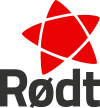
Back حزب الحمر (النرويج) Arabic Partit Roig (Noruega) Catalan Rødt Danish Rødt German Κόκκινο Κόμμα (Νορβηγία) Greek Partido Rojo Spanish حزب سرخ (نروژ) Persian Punaiset (Norja) Finnish Rouge (Norvège) French המפלגה האדומה של נורווגיה HE
Red Party Rødt Raudt | |
|---|---|
 | |
| Leader | Marie Sneve Martinussen |
| Founded | 11 March 2007 |
| Merger of | |
| Headquarters | Dronningens Gate 22, Oslo |
| Youth wing | Red Youth |
| Membership (2022) | |
| Ideology | |
| Political position | Left-wing to far-left |
| Nordic affiliation | Nordic Green Left Alliance[2] |
| Colours | Red |
| Slogan | "Fordi fellesskap fungerer" ("Because community works") |
| Storting | 8 / 169 |
| County Councils | 20 / 574 |
| Municipal Councils | 192 / 9,344 |
| Website | |
| rødt | |
The Red Party (Bokmål: Rødt; Nynorsk: Raudt; Northern Sami: Ruoksat) is a communist political party in Norway.[3] It was founded in March 2007 by a merger of the Red Electoral Alliance and the Workers' Communist Party. A Marxist party, it has been described as left-wing[4][5][6][7] and far-left[8][9][10][11] on the political spectrum. In its political programme, the Red Party sets the creation of a classless society to be its ultimate goal, which the party says is "what Karl Marx called communism".[12] The party's other goals are replacing capitalism with socialism, an expansive public sector and nationalisation of large enterprises. It has a revolutionary socialist ideology, which aims towards new legislatures taking power on behalf of the workers,[13] though the party does not support violent armed revolution as espoused by its predecessors in the 1970s and 1980s.[14] It strongly opposes Norway becoming a member of the European Union.[15]
The Red Party has 20 county council representatives nationwide and 193 municipal representatives. In the 2013 parliamentary election, it was the largest party that failed to win a seat. The party entered Parliament in the 2017 election, winning 2.4% of the vote and its first seat ever in the Storting.[16] The last time a far-left party had representation in the Storting was when its predecessor party, the Red Electoral Alliance, won a seat in 1993. In the 2021 parliamentary election, the party achieved its best result ever, with 4.6% of the vote, securing eight seats in Parliament.[17]
- ^ "Ny medlemsrekord i Rødt". Rødt (in Norwegian).
- ^ "Nordic Green Left | Nordic cooperation".
- ^ Nordsieck, Wolfram (2017). "Norway". Parties and Elections in Europe. Retrieved 13 August 2018.
- ^ Björk, Tord (12 January 2019). "How Integrity Initiative and Atlantic Council is exposed in Norway". Steigan.no. Retrieved 24 June 2019.
- ^ Youth Quotas and other Efficient Forms of Youth Participation in Ageing Societies. Chapter author – Petter Haakenstad (P.H.) Godli. Book edited by – Jörg Tremmel, Antony Mason, Petter Haakenstad Godli and Igor Dimitrijoski. P.169. Published in 2015. Published by Springer. Published in Oslo, Norway.
- ^ "Norway – Political parties". Norsk Senter For Forskningsdata. Retrieved 24 June 2019.
- ^ Fossum, John (4 February 2009). "Norway's European Conundrum" (PDF). Retrieved 24 June 2019.
- ^ "Moxnes ny partileder i Rødt". NRK/NTB (in Norwegian). 6 May 2012.
- ^ "Rødts historie". TV 2. 19 February 2009.
- ^ "Rødt". Store Norske Leksikon, 10 September 2013 (in Norwegian)
- ^ Kirk, Lisbeth (12 September 2017). "Norway populists secure second term in government". EUobserver. Retrieved 24 June 2019.
- ^ "Rødt – Fordi fellesskap fungerer". xn—rdt-0na.no (in Norwegian Bokmål). Retrieved 4 January 2018.
- ^ Jan-Arve Overland; Inga Berntsen Rudi; Ragnhild Tønnessen. "Hva står de politiske partiene for?". Nasjonal digital læringsarena (in Norwegian).
- ^ "Dropper væpnet revolusjon". Bergensavisen. 5 February 2007.
- ^ Fossum, John (4 February 2009). "Norway's European Conundrum" (PDF). Retrieved 24 June 2019.
- ^ Cite error: The named reference
Reuters 2017was invoked but never defined (see the help page). - ^ Cite error: The named reference
Reuters 2021was invoked but never defined (see the help page).
© MMXXIII Rich X Search. We shall prevail. All rights reserved. Rich X Search